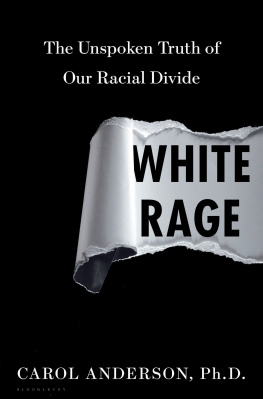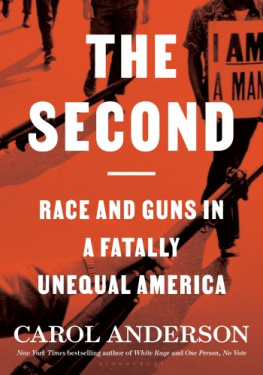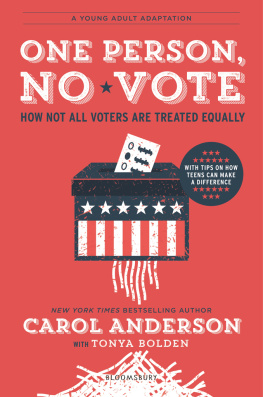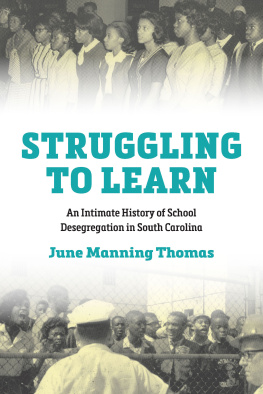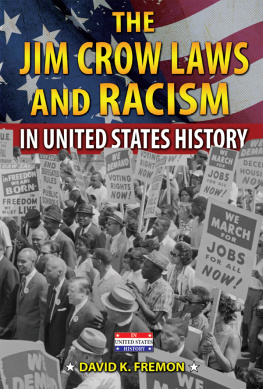
BLOOMSBURY YA
Bloomsbury Publishing Inc., part of Bloomsbury Publishing Plc
1385 Broadway, New York, NY 10018
This electronic edition published in 2018 by Bloomsbury Publishing Plc
BLOOMSBURY and the Diana logo are trademarks of Bloomsbury Publishing Plc
First published in the United States of America in September 2018 by Bloomsbury YA
Copyright 2018 by Carol Anderson
We Are Not Yet Equal is a young adult adaptation of White Rage by Carol Anderson, first published in 2016 by Bloomsbury USA
All rights reserved
You may not copy, distribute, transmit, reproduce or otherwise make available this publication (or any part of it) in any form, or by any means (including without limitation electronic, digital, optical, mechanical, photocopying, printing, recording or otherwise), without the prior written permission of the publisher. Any person who does any unauthorised act in relation to this publication may be liable to criminal prosecution and civil claims for damages.
Bloomsbury books may be purchased for business or promotional use. For information on bulk purchases please contact Macmillan Corporate and Premium Sales Department at
Library of Congress Cataloging-in-Publication Data
Names: Anderson, Carol (Carol Elaine), author.
Title: We are not yet equal : understanding our racial divide / by Carol Anderson.
Other titles: Understanding our racial divide
Description: New York : Bloomsbury, [2018]
Identifiers: LCCN 2018024234 (print) | LCCN 2018025921 (e-book)
ISBN: 978-1-5476-0076-2 (HB)
ISBN: 978-1-5476-0252-0 (PB)
ISBN: 978-1-5476-0078-6 (eBook)
Subjects: LCSH: African AmericansCivil rightsHistoryJuvenile literature. | African AmericansPolitics and governmentJuvenile literature. | African AmericansSocial conditionsJuvenile literature. | WhitesUnited StatesAttitudesHistoryJuvenile literature. | WhitesUnited StatesPolitics and governmentJuvenile literature. | Opposition (Political science)United StatesHistoryJuvenile literature. | RacismUnited StatesHistoryJuvenile literature. | United StatesRace relationsHistoryJuvenile literature.
Classification: LCC E185.61.A5437 2018 (print) | LCC E185.61 (e-book) |
DDC 323.1196/073dc23
LC record available at https://lccn.loc.gov/2018024234
Book design by Vikki Sheatsley
To find out more about our authors and their books please visit www.bloomsbury.com where you will find extracts, author interviews and details of forthcoming events, and to be the first to hear about latest releases and special offers, sign up for our newsletter.
To those who aspired and paid the price
C. A.
For lovers of history, seekers of truth
T. B.
CONTENTS
FOREWORD
My high school US History teacher, Mr. Tripathi, was Indian American. In fact, if I remember correctly, he and I were the only two people in the classroomout of twenty-five or sowith brown skin.
But thats not something we ever talked about. In fact, it took until now, fifteen years later, for me to recognize how remarkable it was that he was the teacher. That fifty years after the first African Americans stepped into a previously segregated school in the South, an Indian immigrant was teaching US History in one of the most racially and socioeconomically diverse high schools in the state of Georgia. Clearly change was possible.
In 1960, one of those first students, six-year-old Ruby Bridges, was escorted into the William Frantz Elementary School in New Orleans by her mother and four federal US Marshals; she spent her entire first day in the principals office. Like Ruby, I was the only black kid in that US History class. Honestly, I was the only black kid in most of my high school classes. Despite Norcross Highs diversity, courses were stratified into three levels: college prep, honors, and gifted-honors/AP/IB. The higher up the class-level pyramid you climbed, the whiterand richerthe classrooms became. I was the token at that gifted honors level.
But back then, it wouldve been in poor taste to point it out.
Which is why I think Mr. Tripathi never acknowledged his ethnicity, despite the fact that it couldve been used as an example of just how far wed come as a nation. Back then, colorblindness was the name of the game. Acknowledging that the only other spot of brown in the US History classroom was the teacherand how problematic that waswouldve been considered divisive. Itd been a long time since Dr. King and his contemporaries did away with Jim Crow during the Civil Rights Movement, and progress meant we were all the same. Racism was no longer a thing.
Except now we know thats notand has never beentrue. Now, statistics show undeniable discrepancies in arrest and incarceration rates along racial lines. Now, unarmed black men and women are gunned down in the streets for nothing more than looking suspicious. Now, people openly gather in the name of white nationalism and raise the Nazi salute as they rally around discriminatory and xenophobic ideas.
Now it cant be denied that racism in America is still very much a thing.
But why? Why are we still here? What paradigms perpetuate racism in our society? What seemingly innocentif not patrioticideas are actually racist in origin?
And what do we do about it? What do we say? Racism is a topic so fraught, so taboo these days, the very mention of it causes instant discomfort for most people. How do we discuss both the origins of American racism and its manifestationspast and presentin a way that leads to mutual understanding and a desire for change? Is that even possible?
I think it is.
And I think this book, this journey from the end of American chattel slavery through the twentieth century and into the present dayexposing the roots of American racism, as well as the branches, boughs, and still-sprouting leavesis an excellent place to start.
Nic Stone
PROLOGUE
KINDLING
The seed for this book began to germinate many years ago, in the aftermath of a black mans death at the hands of the police: that of Amadou Diallo, a twenty-two-year-old West African immigrant. Diallo was mowed down in a hail of New York Police Department (NYPD) bullets on February 4, 1999, as he stood in the vestibule of his apartment building in the Soundview section of the Bronx, New York.
Though the killing was horrific enoughthe police fired forty-one bullets, nineteen of which hit their targetwhat was truly stunning was the policy rationale espoused by New York City mayor Rudy Giuliani. On the news show Nightline, the mayor, virtually ignoring Diallos death, glibly spouted one statistic after the next to demonstrate how the NYPD was the most restrained and best behaved police department you could imagine.
Mayor Giuliani touted policies that had reduced crime in New York City, and dismissed black peoples concerns about racial profiling, stop and frisk, and police brutality. If those poorer neighborhoods that happened to be primarily black did not have this increased police activity, he asserted, the police would be accused of caring only about the affluent. Giuliani then countered that the real issue was the communitys racism against the police and unwillingness to take responsibility for the issues plaguing their neighborhoods.
But restrained and behaved police dont fire forty-one bullets at an unarmed man. Moreover, New Yorks aggressive law enforcement policy appeared to expend most of its energy on the groups bringing the smallest yield of criminal activity. In 1999, blacks and Latinos, who made up 50 percent of New York Citys population, accounted for 84 percent of those stopped and frisked by the NYPD, while the majority of illegal drugs and weapons were found on the relatively small number of whites detained by police.



